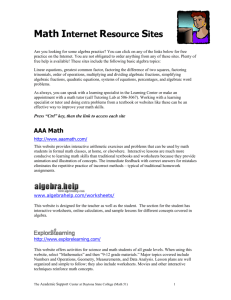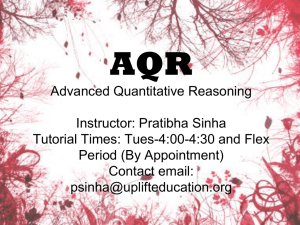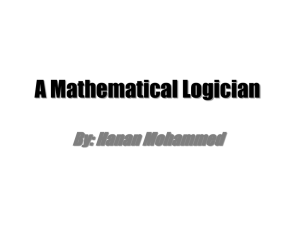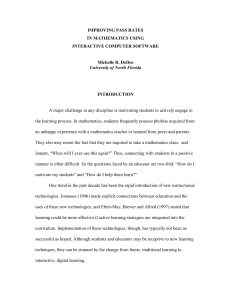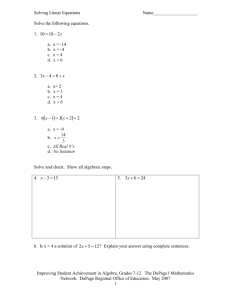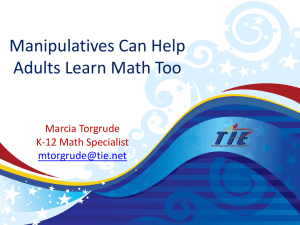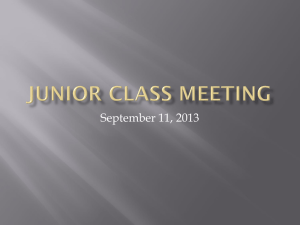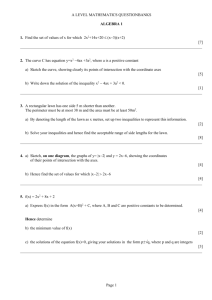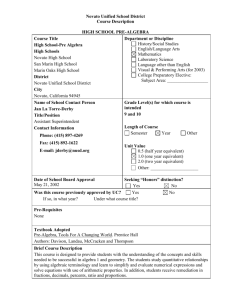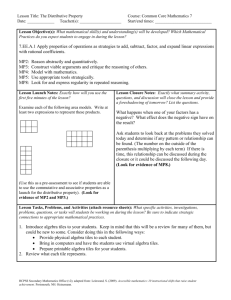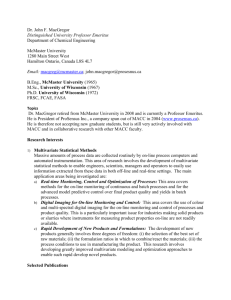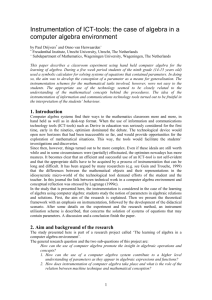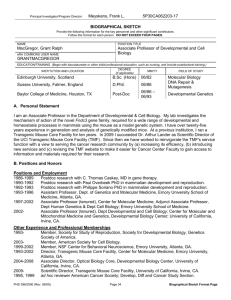Algebra has it`s root in the early grades when children notice
advertisement
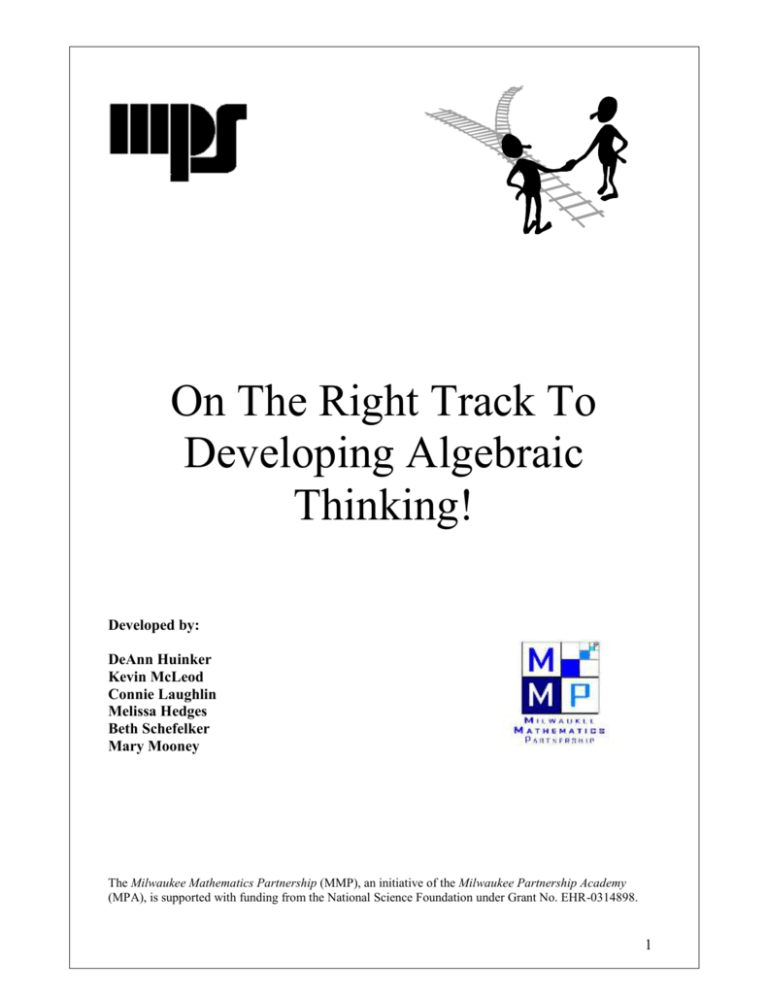
On The Right Track To Developing Algebraic Thinking! Developed by: DeAnn Huinker Kevin McLeod Connie Laughlin Melissa Hedges Beth Schefelker Mary Mooney The Milwaukee Mathematics Partnership (MMP), an initiative of the Milwaukee Partnership Academy (MPA), is supported with funding from the National Science Foundation under Grant No. EHR-0314898. 1 Session Goals To recognize the structure of operations within the context for whole numbers, fractions, decimals. To develop general understandings of the operations and recognize that the same structure exists for other number systems. 2 Algebra has its root in the early grades when children notice regularities in the ways that numbers work. From this beginning, they develop a knowledge of the properties of numbers and operations, later generalized as Algebra. MacGregor, M. & Stacey, K. (1999). A flying start to algebra. Teaching Children Mathematics, October, pp. 78-85. 3 Five aspects of number knowledge essential for algebra learning Understanding equality Recognizing the operations Using a wide range of numbers Understanding important properties of number Describing patterns and functions MacGregor, M. & Stacey, K. (1999). A flying start to algebra. Teaching Children Mathematics, October, pp. 78-85. 4 What Research Tells Us 1. Students find algebra hard to learn unless they have a good knowledge of number properties and basic operations. 2. Students need to be able to think about the general effects of operations on numbers and not focus their attention only on getting answers. 3. Students need to feel comfortable using large numbers, fractions, and decimals so that they can recognize when a rule applies to the whole range of numbers. MacGregor, M. & Stacey, K. (1999). A flying start to algebra. Teaching Children Mathematics, October, pp. 78-85. 5 MKT CABS Think of a number expression that uses 2 numbers. Write a contextual situation for that expression. Set your situation aside for future use. 6 Story Problem Survey Work through the problems as a group. Write a number sentence for each story problem. Discuss why that number sentence fits with that story. Be sure everyone understands the reasoning behind the number sentence written for each question. 7 Have We Locked Students into A Certain Way of Thinking? Generally, teachers break down a complex problem into small steps so that the solution becomes a collection of simple computations. Some teachers and many textbooks tend to restrict students’ experiences to the use of small whole numbers instead of using a wide-range of numbers. Students enter middle school having a limited experience with numbers other than small whole numbers. Students are not sure whether the procedures they have learned to use with these numbers can also be used for large numbers, decimals, and fractions. MacGregor, M. & Stacey, K. (1999). A flying start to algebra. Teaching Children Mathematics, October, pp. 78-85. 8 Looking at Student Work 1. Identify a facilitator. 2. Look carefully at the pieces of student work. 3. Do not discuss the papers with your table group. 4. Use the recording sheet to note specific ideas that surfaced from the work. Keep these questions in mind when you are looking at the work: What do you see? What do the students understand? What questions does this work raise? 9 Sharing Ideas About Student Work As a table group, discuss aspects of the student work you noted individually. Use the group recording sheet to collect the various ideas. Table leaders should be prepared to share one (1) idea from your discussion. Make sure to have a back-up idea ready. 10 What Are Some Ways To Solve These Problems? Each section of the Bradley Center holds 258 people. There are 72 sections. If all of the seats are filled for a Buck’s game, how many people would there be? How many bows can you make from 3 2/3 meters of ribbon if you need 2/5 meters of ribbon to make each bow? 11 Would The Same Methods Work Now? Each section of the Bradley Center holds p people. There are s sections. If all of the seats are filled for a Buck’s game, how many people would there be? How many bows can you make from r meters of ribbon if you need m meters of ribbon to make each bow? 12 NCTM says… The NCTM’s Curriculum and Evaluation Standards for School Mathematics (1989, 91) states that “students in grades 5-8 should have the opportunity to understand how the basic arithmetic operations are related to one another.” …To use algebra for solving a problem, the focus of attention is not on getting numerical answers to each step of the solution but on the operations used. 13 The Question Then Is… How do you develop operation sense in children? 14 Sorting Problems Use the cards in your envelope to make categories of problems. Sort the cards according to the operation needed to solve the question. Question to keep in mind… What led you to the operation you chose for each category of cards? 15 MKT Explore the same problem in a variety of ways. Find out what happens when different numbers (fractions, decimals, large numbers) are used. Encourage operation sense. Avoid “key words.” Allow children to “attack” problems in ways that make sense to them. As operation sense develops, identify operations needed to solve problems. Algebraic thinking is supported when the operation needed to solve the problem is highlighted. Example: Repeated subtraction/division 16 MKT CABS Take a closer look at the story problem you wrote earlier in the session. Did you “lock yourself into a certain way of thinking?” Using the problem you wrote earlier in the session... In what way would changing the number system, or using variables, extend thinking about the mathematical operation presented in the problem? Rewrite the problem and describe how the operation works with your new number choice. 17

